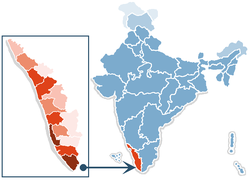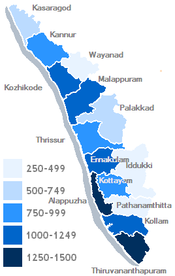- Demographics of Kerala
-
Location of Kerala in India 
Kerala is a state in south-western India. Most of Kerala's 31.8 million people are of Malayali ethnicity. Malayali Hindus derive their ancestry from Dravidian and Aryan communities that settled in Kerala and intermixed.[1] Additional ancestries derive from several centuries of contact with non-Indian lands, whereby thousands of people of Arab, Jewish, and other ethnicities settled in Kerala. Many of these immigrants intermarried with native Malayalees.[2][3] Muslims thus take lineage from Arab settlers mixed with local population, where as Syrian Christians take that of Jews mixed with locals.
Malayalam is Kerala's official language and is spoken by at least 96% of Keralites; the next most common language is Tamil, spoken mainly by Tamil workers from Tamil Nadu. Tulu and Kannada is spoken in some parts of the northern districts of Kasaragod, adjoining Karnataka. In addition, Kerala is home to 321,000 indigenous tribal Adivasis (1.10% of the populace).[4] Some 63% of Adivasis reside in the eastern districts of Wayanad (where 35.82% are Adivasi), Palakkad (11.05%), and Idukki (15.66%).[5] These groups, including the Irulars, Kurumbars, and Mudugars,[6] speak their own native languages and experience hardships such as racial discrimination, economic exploitation, and poverty.[7][8][9] Cholanaikkan tribe in Silent Valley National Park were contacted only in 1970s and they are the most isolated tribe. There were 64,008 Konkani speakers in Kerala in 1991.
Population
Population density of Kerala
Kerala's districts, shaded by population density. Source: (GOK 2001). Kerala is home to 2.76% of India's people, and — at 859 persons per km² — its land is three times as densely settled as the rest of India. However, Kerala's population growth rate is far lower than the national average. Whereas Kerala's population more than doubled between 1951 and 1991 — adding 15.6 million people to reach a total of 29.1 million residents in 1991 — the population stood at less than 32 million by 2001 and 33.3 million in 2011. Kerala's people are most densely settled in the coastal region, leaving the eastern hills and mountains comparatively sparsely populated.[10]
Religion
The major religions followed in Kerala are Hinduism (56.2% — predominantly Ezhavas and SCs), Islam (24.7% — Keralite Muslims from northern part of the state , and Christianity (19.00%).[11] Kerala also had a tiny Jewish population until recently, said to date from 587 BC when they fled the occupation of Jerusalem by Nebuchadnezzar.[12] The 2001 Indian census recorded only 51 Jews in Kerala. The synagogue in Kochi is the oldest in the Commonwealth of Nations. The state has many famous Temples, Mosques, and Churches. The oldest church in India is found in Palayoor, purportedly constructed in A.D. 52 by St. Thomas. Importantly, Kerala has one of the most secular majority populations in India.
Social development
Kerala ranks highest in India with respect to social development indices such as elimination of poverty, primary education and healthcare.[citation needed] This resulted from significant efforts begun in 1911 by the erstwhile Cochin and Travancore states to boost healthcare and education among the people. This central focus — unusual in India — was then maintained after Kerala's post-independence inauguration as a state.[13] Thus, Kerala has the highest literacy rate in India of 91% (2001);[14] and life expectancy is now the highest in India. However, the same is true of Kerala's unemployment and suicide rates. As per the 2001 census, Kerala is the only state in India with a female-to-male ratio higher than 0.99. The ratio for Kerala is 1.058 — 1059 females per 1000 males — while the national figure is 0.933.[15] It is also the only state in India to have sub-replacement fertility. UNICEF and the World Health Organization (WHO) designated Kerala the world's first "baby-friendly state" via its "Baby Friendly Hospital Initiative". The state is also known for Ayurveda, a traditional system of medicine — this traditional expertise is currently drawing increasing numbers of medical tourists. However, drawbacks to this situation includes the population's steady aging — indeed, 11.2% of Keralites are age 60 or over.[13]
Kerala's unusual socioeconomic and demographic situation was summarized by author and environmentalist Bill McKibben:[16]
-
Kerala, a state in India, is a bizarre anomaly among developing nations, a place that offers real hope for the future of the Third World. Though not much larger than Maryland, Kerala has a population as big as California's and a per capita annual income of less than $300. But its infant mortality rate is very low, its literacy rate among the highest on Earth, and its birthrate below America's and falling faster. Kerala's residents live nearly as long as Americans or Europeans. Though mostly a land of paddy-covered plains, statistically Kerala stands out as the Mount Everest of social development; there's truly no place like it.[16]
Immigration
There are more than 1,000,000 migrants living in Kerala,[17] mostly from Bangladesh and West Bengal, constituting more than 3% of the population. There are also migrants from Bihar, Jharkhand, Chhattisgarh, Orissa, and the North East.[18] In some places like Perumbavoor they outnumber the locals.[19] Some alarmist have even wrote that "off late, Kerala has been hearing more Bengali than its own local language",[20] which is a huge exaggeration, since there are very few migrants in Northern and Southern Kerala. Most of the migrants tend to concentrate around central Kerala, especially in Cochin (Notable exceptions would be Trivandrum and Calicut. In Calicut, Northern immigrants constitute more than 8% of the total population, at 35,000).[17]
Studies indicate that by the time of 2016 state elections, migrants will become a crucial voting block in many of the constituencies in Thiruvananthapuram, Kochi, Kozhikode, Thrissur and Kannur.[21] This is expected to boost the LDF, as migrant workers tend to support Communist parties.
Additional demographic information
Nationality
Indian
Population
- 31,841,374 (2008 Census)
- Males : 15,471,420
- Females : 16,369,955
Class I Cities of Kerala
As of 2011, Kerala is almost 50% urban. Kerala has seven million-plus towns - Kochi, Kozhikode, Thrissur, Malappuram, Thiruvananthapuram, Kannur and Kollam. More than one in every three of its residents lives in a big city. That is a higher proportion than for any other state.[22]
According to Census of India 2001,[23] following are the list of Class I Major Towns classified as Urban Agglomerations..
City/Town Population Rank Kochi 1355972 1 Thiruvananthapuram 889635 2 Kozhikode 880247 3 Thrissur 498207 4 Kollam 380091 5 Kannur 330122 6 Palakkad 282675 7 Alappuzha 197369 8 Kottayam 172878 9 Malappuram 170409 10 Cherthala 141558 11 Guruvayoor 138681 12 Kasaragod 129367 13 Wayanad 124083 14 According to World Gazetteer[24] population calculation for the year 2010, five of the top 100 most populous metropolitan areas in India belong to Kerala. They are Kochi, Thiruvananthapuram, Kozhikode, Kannur and Kollam ranking 26, 43, 46, 73 and 86 respectively.
Ethnic groups
The great majority of residents of Kerala are Malayalis, but there are many smaller ethnic groups including Tuluvas, Tamils, Kannadigas and Konkanis.
Religion/Caste Communities
- Ezhavas - 22.91%
- Nairs - 12.88%[25]
- Syrian Christians (Including Syro-Malabar Catholic, Syro-Malankara Catholic, Jacobite, Orthodox, Marthomite & Chaldean) - 12.25%[26]
- Latin Christians - 4.28%[26]
- Muslims 24.70%
- Pulaya - 3.27%[27]
- Brahmins - 1.59%[25]
- Hindu Tribals - 1.07%[28]
- Cheruman - 0.99%[27]
- Kuravar - 0.84%[27]
- Christian Tribals - 0.07%[28]
- Christian Nadar - 1.04%[26]
- Other Christian - 1.35%[26]
- Other SC - 4.71%[27]
- Viswakarmas - 0.3%[25]
- Ambalavasi - 0.2%[25]
- Others (Dheevara, etc.) - 6.00%
Age structure
- 0-6 years: 3,793,146 or 11.91% (male 1,935,027/female 1,858,119)
- 0-14 years: 30.69%
- 15-64 years: 63.87%
- 65 years and over:5.44% (1991 Cen)
Median age
- Year :1961 1971 1981 1991 2001
- Total:19.28 19.39 21.81 24.36 28.87
- Male:
- Female:
Population growth rate
- 0.87% (1998 est.)
Birth rate
- 17.1 births/1,000 population (1994-2001 est.) [1]
- In 2007, 45.88% of all live births were Hindus, 33.71% Muslims and 18.02% Christians.[29]
- In 2008, 45.04% of all live births were Hindus, 36.32% Muslims and 17.58% Christians.[30]
Birth Rate was 17.1 in 1994-2001 (20.3 in 1984-1990 & 25.0 in 1974-1980) . Pathanamthitta (14.5 in 1994-2001, 17.2 in 1984-1990 & NA in 1974-1980) had the lowest TBR and Malappuram(22.4, 29.5 & 33.6) had the highest TBR.
District TBR 1974-1980 TBR 1984-1990 TBR 1994-2001 TFR 1974-1980 TFR 1984-1990 TFR 1994-2001 Trivandrum 22.8 19.6 16.4 2.3 1.8 1.6 Kollam 23.3 18.5 16.2 2.7 1.8 1.6 Alappuzha 21.0 16.7 15.2 2.3 1.6 1.5 Pathanamthitta n.a 17.2 14.5 n.a 1.7 1.5 Kottayam 20.1 16.6 15.6 2.4 1.7 1.6 Idukki 26.7 19.8 17.0 2.9 1.8 1.6 Ernakulam 21.4 16.9 15.7 2.4 1.6 1.5 Thrissur 22.2 18.7 16.1 2.5 1.9 1.6 Palakkad 22.5 18.8 17.3 3.4 2.4 1.8 Malappuram 33.6 29.5 22.4 4.3 3.4 2.4 Kozhikode 26.3 20.5 17.4 3.0 2.0 1.7 Wayanad 31.4 23.4 19.5 3.8 2.3 2.0 Kannur 28.8 20.5 16.6 3.5 2.1 1.7 Kasaragod n.a 24.4 18.9 2.5 n.a 1.9 Kerala 25.0 20.3 17.1 2.9 2.0 1.7 Death rate
- 7.0 deaths/1,000 population (2006-10)[31]
- In 2007, 61.55% of the deaths were reported from Hindus, 17.50% from Muslims and, 19.75% from Christians.[29]
- In 2008, 61.01% of the deaths were reported from Hindus, 17.82% from Muslims and, 20.06% from Christians.[30]
Net migration rate
- (-)3.1 migrant(s)/1,000 population (1991 est.)
Of the emigrants from Kerala, 42.2% were Muslims, 36.6% were Hindus and 21.2% were Christians in 1992-93. The most preferred destination was USA (37.8%), followed by UAE (25.9%), Other Gulf countries (13.0%), Oman (11.8%), Other Countries (7.5%) and Saudi Arabia(3.8%). [2]
Sex ratio
- Total population : 1058 Females/1000 Male
- Age 0-6 : 987 Females/1000 Males
Infant mortality rate
- Total: 14.1 deaths/1,000 live births (1997-1999)
Maternal mortality rate
- Total: 1.3 deaths/1,000 live births (1990)
Life expectancy at birth
Total fertility rate
- 1.70 children born/woman (2001 Cen)
In 1991, Kerala had the lowest TFR (Children born per women) in the whole of India. Hindus had a TFR of 1.66, Christians had 1.78 and Muslims had 2.97. In 2000, the TFR was 1.73 with Muslims having 2.28, Nairs having a TFR of 1.47 and Syrian Christians having TFR of 1.55. TFR for Scheduled Castes was 1.52 in 1997-98 and 1.37 in 1992-93. The lowest Fertility rate recorded anywhere in India is TFR of 1.17 for Vettuvan caste in Kerala. [3]
HIV/AIDS
- HIV/AIDS - adult prevalence rate: 0.32% (2005 est.)
- HIV/AIDS - people living with HIV/AIDS: NA
- HIV/AIDS - deaths: NA
See also
References
- ^ Social and cultural history of Kerala by A. Sreedhara Menon p47,p61
- ^ Western Influence on Malayalam Language and Literature by K. M. George, p2, ISBN 8126004134 Google book
- ^ Caste, Class and Catholicism in India 1789-1914 by Kenneth Ballhatchet, p2, ISBN 0700710957
- ^ (Kalathil 2004, p. 10).
- ^ (Kalathil 2004, p. 12).
- ^ (Kalathil 2004, pp. 13–14).
- ^ (Kalathil 2004, pp. 30–32).
- ^ (Kalathil 2004, p. 37).
- ^ (Kalathil 2004, p. 39).
- ^ (GOK 2005b).
- ^ Indian Census
- ^ Edna Fernandes, The Last Jews of Kerala, Skyhorse Publishing, 2008
- ^ a b (Varma 2005).
- ^ http://www.censusindia.gov.in/
- ^ (UNDP 2001, p. 1).
- ^ a b (McKibben 2006).
- ^ a b http://www.frontlineonnet.com/fl2801/stories/20110114280104400.htm
- ^ http://www.indianexpress.com/news/in-migrants-own-country/821311/0
- ^ http://www.telegraphindia.com/1080810/jsp/7days/story_9671372.jsp
- ^ http://www.premiuminvestments.in/corporate-inklings/57556p104/57503.html
- ^ http://www.telegraphindia.com/1110420/jsp/nation/story_13877410.jsp
- ^ http://timesofindia.indiatimes.com/india/One-in-3-Keralites-lives-in-big-cities/articleshow/10514023.cms
- ^ Office of the Registrar General and Census Commissioner Government of India (2001) (PDF). Census of India 2001:List of Towns. pp. 1–4. http://www.censusindia.gov.in/towns/ker_towns.pdf. Retrieved 2006-01-12.
- ^ "India: metropolitan areas". World Gazetteer. http://www.world-gazetteer.com/wg.php?x=&men=gcis&lng=en&dat=80&geo=-104&srt=pnan&col=aohdq&msz=1500&va=&pt=a. Retrieved 17 February 2010.
- ^ a b c d Socio-Economic Survey 1968 http://www.jstor.org/pss/4367366
- ^ a b c d . JSTOR 2800388.
- ^ a b c d http://censusindia.gov.in/Tables_Published/SCST/dh_sc_kerala.pdf
- ^ a b http://censusindia.gov.in/Tables_Published/SCST/dh_st_kerala.pdf
- ^ a b http://www.ecostat.kerala.gov.in/pdf/reports/vital_stat/bulletin_07.pdf
- ^ a b http://www.cr.lsgkerala.gov.in/Docs/AnnualVitalStatisticalReport_2008.pdf
- ^ http://www.indiastat.com/table/health/16/deathrate/17792/480170/data.aspx
Categories:- Kerala society
- Demographics of India
-
Wikimedia Foundation. 2010.

